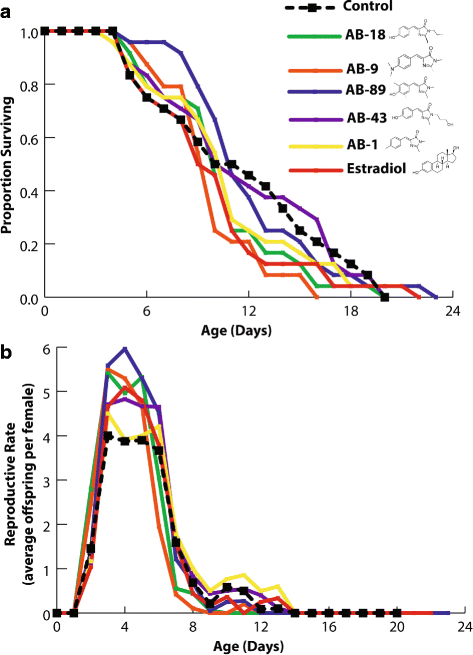Conservation of estrogen receptor function in invertebrate reproduction
- PMID: 28259146
- PMCID: PMC5336670
- DOI: 10.1186/s12862-017-0909-z
Conservation of estrogen receptor function in invertebrate reproduction
Abstract
Background: Rotifers are microscopic aquatic invertebrates that reproduce both sexually and asexually. Though rotifers are phylogenetically distant from humans, and have specialized reproductive physiology, this work identifies a surprising conservation in the control of reproduction between humans and rotifers through the estrogen receptor. Until recently, steroid signaling has been observed in only a few invertebrate taxa and its role in regulating invertebrate reproduction has not been clearly demonstrated. Insights into the evolution of sex signaling pathways can be gained by clarifying how receptors function in invertebrate reproduction.
Results: In this paper, we show that a ligand-activated estrogen-like receptor in rotifers binds human estradiol and regulates reproductive output in females. In other invertebrates characterized thus far, ER ligand binding domains have occluded ligand-binding sites and the ERs are not ligand activated. We have used a suite of computational, biochemical and biological techniques to determine that the rotifer ER binding site is not occluded and can bind human estradiol.
Conclusions: Our results demonstrate that this mammalian hormone receptor plays a key role in reproduction of the ancient microinvertebrate Brachinous manjavacas. The presence and activity of the ER within the phylum Rotifera indicates that the ER structure and function is highly conserved throughout animal evolution.
Keywords: Estrogen receptor; Receptor; Rotifera.
Figures





Similar articles
-
Conservation of progesterone hormone function in invertebrate reproduction.Proc Natl Acad Sci U S A. 2010 Jun 29;107(26):11859-64. doi: 10.1073/pnas.1006074107. Epub 2010 Jun 14. Proc Natl Acad Sci U S A. 2010. PMID: 20547846 Free PMC article.
-
Evolutionary origins of the estrogen signaling system: insights from amphioxus.J Steroid Biochem Mol Biol. 2011 Nov;127(3-5):176-88. doi: 10.1016/j.jsbmb.2011.03.022. Epub 2011 Apr 14. J Steroid Biochem Mol Biol. 2011. PMID: 21514383 Free PMC article. Review.
-
Is there potential for estradiol receptor signaling in lophotrochozoans?Gen Comp Endocrinol. 2024 Aug 1;354:114519. doi: 10.1016/j.ygcen.2024.114519. Epub 2024 Apr 25. Gen Comp Endocrinol. 2024. PMID: 38677339 Review.
-
The Octopus vulgaris estrogen receptor is a constitutive transcriptional activator: evolutionary and functional implications.Endocrinology. 2006 Aug;147(8):3861-9. doi: 10.1210/en.2006-0363. Epub 2006 May 11. Endocrinology. 2006. PMID: 16690796
-
Analysis of 3D models of octopus estrogen receptor with estradiol: evidence for steric clashes that prevent estrogen binding.Biochem Biophys Res Commun. 2007 Sep 28;361(3):782-8. doi: 10.1016/j.bbrc.2007.07.110. Epub 2007 Jul 30. Biochem Biophys Res Commun. 2007. PMID: 17678875
Cited by
-
Homology models of mouse and rat estrogen receptor-α ligand-binding domain created by in silico mutagenesis of a human template: molecular docking with 17ß-estradiol, diethylstilbestrol, and paraben analogs.Comput Toxicol. 2019 May;10:1-16. doi: 10.1016/j.comtox.2018.11.003. Epub 2018 Nov 28. Comput Toxicol. 2019. PMID: 30740556 Free PMC article.
-
Of Retinoids and Organotins: The Evolution of the Retinoid X Receptor in Metazoa.Biomolecules. 2020 Apr 11;10(4):594. doi: 10.3390/biom10040594. Biomolecules. 2020. PMID: 32290525 Free PMC article.
-
Nuclear Receptors and Development of Marine Invertebrates.Genes (Basel). 2021 Jan 11;12(1):83. doi: 10.3390/genes12010083. Genes (Basel). 2021. PMID: 33440651 Free PMC article. Review.
-
Genomic signatures of local adaptation to the degree of environmental predictability in rotifers.Sci Rep. 2018 Oct 30;8(1):16051. doi: 10.1038/s41598-018-34188-y. Sci Rep. 2018. PMID: 30375419 Free PMC article.
-
Long-term exposure of marine mussels to paracetamol: is time a healer or a killer?Environ Sci Pollut Res Int. 2021 Sep;28(35):48823-48836. doi: 10.1007/s11356-021-14136-6. Epub 2021 Apr 30. Environ Sci Pollut Res Int. 2021. PMID: 33928507 Free PMC article.
References
MeSH terms
Substances
Grants and funding
LinkOut - more resources
Full Text Sources
Other Literature Sources

